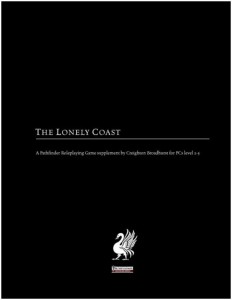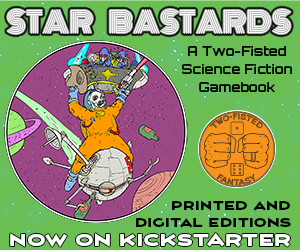The Lonely Coast
The Lonely Coast is a campaign setting for the Pathfinder Roleplaying Game published by Raging Swan Press.
By Creighton Broadhurst
Welcome to the second Designer’s Diary, a regular column where designers are given the opportunity to take readers on an in-depth ride through the design and development process of their system, setting, or product.

Designer’s Description
The Lonely Coast is a gritty, frontier place designed to form the backdrop of a party’s first few adventures. While it has a lot of detail crammed into it, it is specifically designed so that it could be dropped into almost any GM’s campaign world. This gives you a better feel for the place:
“The furthest flung outpost of a mighty kingdom, turbulent waters and forbidding, trackless forests separate the folk of the Lonely Coast from the gaudy lights of civilisation. Pirates and slavers ply the southern storm-tossed waters while goblins and other foul things creep through the gloom of the Tangled Wood that seemingly chokes the forgotten holds and sacred places of the Old People. Deep within the forest, a narrow, rock-choked defile piled deep with shadow cuts through a nameless range of rugged, tree-shrouded hills birthing dark, fearsome legends of terrifying monsters and glittering, doom-laden treasures. The perils of the Lonely Coast are legion and thus there is always a need for those with stout hearts and skill with blade and spell or for those merely hungry for glory to defend humanity’s most tenuous enclave.”
Purpose
Firstly, I wanted to design a small self-contained area that a GM could use to start a new campaign. I believe that when you start a campaign you should start small. Concentrate on the basics and make the immediate environment come alive for the PCs. While it’s great to had loads of information about the continent and many faraway lands, the often has no impact whatsoever on game play,
Influences
I love Raymond E. Fiest’s Riftwar Saga. The feel of The Lonely Coast is very much based on the the duchy of Crydee which gets a lot of detail in the trilogy’s first part, Magician.
Research
Loads; I’m a details man. I looked into the kinds of animals and plants you’d expect to find in that environment and what medieval folk did at different times of the year (planting, reaping etc). I think that kind of detail adds cohesion and “realism” to a setting. While I don’t want a game to get bogged down in being historically accurate to the nth degree, I think some such details should be available to the GM as it grounds the setting in “reality”.
Art Direction
Art is really important; it sets a tone for the product in the GM’s mind. That’s important because the GM is the PCs only (or at the very least main) conduit of information about the setting. Inspire the GM and you inspire the players.
Gaming Experience
The Lonely Coast presents a low-level area suitable for a short campaign. The characters are on the very edge of civilisation and must help both defend what has been won and explore the trackless wastes of the forest in search of ancient treasure and ferocious monsters.
Comparison
I’m not certain I can answer this question as I’m not aware of any similar products. That’s not because The Lonely Coast is amazing and unique, it’s because I don’t have as much time as I’d like to read!
Development Process
The most important things are to write what you love and to come up with a good, basic idea. Once I’ve come up with a good, basic idea I normally leave it in my brain for some time and mull it over. I also make a lot of notes. Thus, when I get started I’m normally quite quick at actually writing something.
The next thing I do is lockdown the product’s storyboard, so when I actually start writing I know I need x number of words for feats, x number of words for new monsters and so on. I find that this allows me to focus on getting the requisite number of words done without worrying that I am wasting time designing stuff that will never get off my hard drive.
Skipping over the actual writing process (because this is different for every type of product – supplements, adventures and so on) you can never get enough people to edit what you’ve written once you’ve finished. You personally need to edit (and possibly redraft) the text at least twice before it is ready to release. This won’t make it perfect, but it will eradicate most typos and howling errors. That level of care and commitment to the product shine through in the final version.
Finally, at all times while writing a product I keep in mind how the product will be used at the table and what it brings to the gaming experience. If it’s not making the game better or faster, I rewrite it until it does.
About the Designer
Creighton is a keen gamer who passionately believes in the Open Gaming License and is dedicated to making his games as fun and easy to enjoy as possible for all participants. Reducing or removing entry barriers, simplifying pre-game prep and easing the GM’s workload are the key underpinning principles of the products he releases through Raging Swan Press.
Over the last 11 years, Creighton has worked with Expeditious Press, Paizo and Wizards of the Coast. He now releases his own products through Raging Swan Press. You can read his thoughts on game design at raging-swan.livejournal.com.
Creighton lives in Torquay, England where, apparently, the palm trees are plastic and the weather is warm. He shares a ramshackle old mansion with his two children (“Genghis” and “Khan”) and his patient wife. Famed for his unending love affair with booze and pizza he is an enduring GREYHAWK fan.
About the Lonely Coast
You can learn more about The Lonely Coast, including downloading a free copy, at http://www.ragingswan.com/lonely.html.



